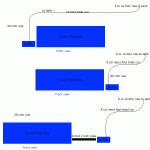A
Anonymous
Guest
In regard to Wazzel and Dan's discussion about wattage and flow rate, the curve (wattage vs GPH) is not linear. Generally, the lower the head pressure (the faster the flow rate), the more energy the pump going to use. The difference between dead flow (totally blocked) and full throttle can be 200% or more (that is, (d-b)/d ). In the usually operating range with low viscosity fluid, Wazzel's statement is accurate.






